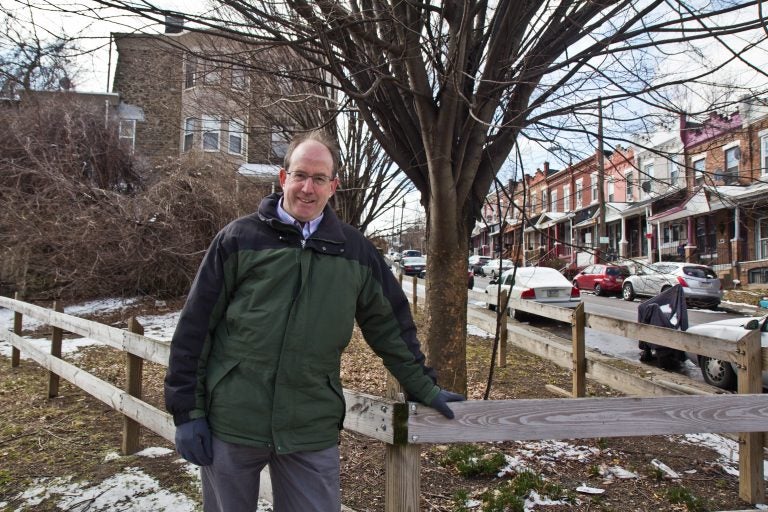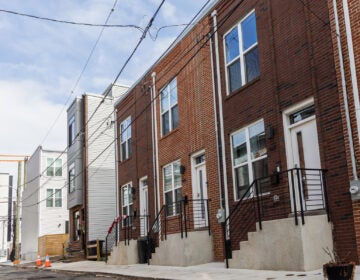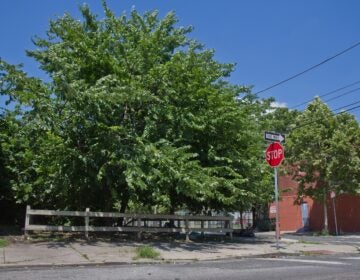How City Council broke Philly’s app for selling blighted land
At the current pace, it will take the City of Philadelphia 50 years to sell off its publicly owned vacant land.

Developer Ken Weinstein at a lot he tried to purchase from the city in Philadelphia’s Wayne Junction neighborhood. (Kimberly Paynter/WHYY)
This article originally appeared on PlanPhilly.
—
When developer Ken Weinstein wanted to buy two vacant lots from the city of Philadelphia, he went online. The city has an app for selling off its thousands of unused publicly owned lots — a website that resembles popular real estate search tools Trulia or Zillow with an interactive map of lots for sale.
Weinstein clicked on a small, oddly shaped parcel close to a few bigger sites he was developing, filled out an online questionnaire explaining how he wanted to use the property and pressed enter to submit his application. Five years later, the Germantown developer is still waiting for a response.
“It’s a black hole,” said Weinstein.
He is not alone in that perception. Weinstein’s expression of interest is one of nearly 20,000 applications received through the online portal over seven years that never received a response. Marketed by the city as the “front door” for public land sales, the website was supposed to make it easier to buy vacant properties and help Philadelphia solve its formidable blight problem.
But city records and interviews with officials past and present indicate that the system never worked as intended and has rarely facilitated public sales.
The backlog of more than 18,606 applications includes submissions, known as “expressions of interest” as old as the portal itself, dating back to 2012. The vast majority of unresolved EOIs have been open for at least a year.
Meanwhile, few lots ever sell. Over the past fiscal year, the city’s inventory of 4,811 vacant lots decreased by a net total of only 78 properties — 1.5 percent — as the result of sales.
At the current pace, it would take about half a century to sell off the fallow lots city officials consistently say they want to turn over for development
When properties don’t sell, taxpayers are saddled with the cost of keeping them mowed and clear of illegal dumping while losing out on any tax revenue they could be generating. Sometimes, neighbors end up living next door to a mess or, in extreme cases, a hazard.
Whether the city’s online “front door” results in sales, it does manage to generate traffic. The city accepts thousands of new buyer applications every year — and the backlog has exploded as real estate has grown more valuable. Records show that the city received 4,611 new open applications for land during the last year alone.
‘Backstories’ blocking city sales
Tom Earle, an affordable housing developer, skips the city’s online application altogether. Instead, he acquired two city-owned lots by going straight to City Council offices and getting support to move the sales forward there.
Earle said the city’s advertised process for dispatching its land does not reflect reality. Council members determine which lots move toward sale, he said, not an online application.
“It should work in a more open and transparent way, with less interference from Council,” Earle said. “It slows down the whole process.”
The city’s property app was supposed to solve this problem. John Carpenter, a former deputy executive director for the Philadelphia Redevelopment Authority, helped set up the first version of the online inventory. He said it was explicitly meant to make public land holdings more transparent while creating the bones of a centralized system for moving unwanted lots to sale.
The website went live, but that centralized system never materialized. Carpenter said Council members and the administration could never agree on how to handle lots where multiple parties were interested in the same property and favoring one prospective buyer with a sale might anger all the others.
The problem is that the city’s most desirable lots often attract many would-be buyers. Carpenter thought the answer to the question of how to dispatch the lots fairly was a solution used in many other cities: a public auction.
“But when we took those lists to Council we found that almost every property had a backstory that generated pushback,” Carpenter said.
The most salable lots often wind up stuck in limbo for years waiting for a Council member to decide their fate. One lot, owned by the city since 1986, sits in the middle of the booming Fairmount neighborhood, where nearby vacant land recently sold for upwards of $125,000.
The portal for land sales, which is today housed on the website for the city’s Land Bank, long explicitly stated that it offered “real estate for sale. But during the process of reporting this story, that description changed. The website now states that it merely allows buyers to indicate their “interest in a property” — in other words, don’t call us, we’ll call you.
The app’s sale section includes no mention of the council’s role in the process.
A $7,000 sale dropped, no explanation
Weinstein submitted expressions of interest for two city lots, once in 2014 and once in 2016.
In the first instance, the city actually offered him a small vacant lot near Wayne Junction for about $7,000, documents show. But officials inexplicably dropped the sale after he agreed to their price, Weinstein said.
“We followed up a half-dozen times. We were ready to purchase, and we had a good use for the land as a community park,” Weinstein said.
The second time the developer applied for land, he received an automated response message. The email said that the city planned to sell the property through a competitive bidding process — a process that never happened.
Weinstein said his frustration came from the system’s opacity, never knowing whether an application would move forward or not, let alone why it had been rejected.
“I know the disposition of all city properties get City Council approval. So you have to assume that’s one roadblock,” he said. “Maybe someone decided a friend wanted it. But you don’t know.”
Paul Chrystie, a spokesman for the city’s land dispensation agencies, said in an email that some land faces legitimate obstacles to sale — unqualified buyers or legal problems involving tangled titles and liens. The backlog is reflective of multiple buyers submitting applications for the same few lots in a few hot neighborhoods, he said.
“To date, approximately 4,000 [expressions of interest] have been closed, but that feature does not accurately reflect the achievement of the agencies,’’ Chrystie said. “The real metric is that we’re moving properties out the door.”
But the city spokesman acknowledges flaws with the current system. For example, the city’s online application currently does not distinguish between lots that have already been earmarked for redevelopment projects or other use agreements. Chrystie said about 3,500 open expressions of interest had been submitted for lots that can never be sold.
The city’s charter and state law require a City Council vote to approve land sales. But many Council members take a more granular approach, a strategy their small staffs are ill-equipped to take on. Employees at the city’s land sale agencies — who are not authorized to speak to reporters — said that despite Council’s involvement in land deals, their offices have little practical connection to online sale applicants.
“Council people are not regularly notified” about expressions of interest, said one staffer. “It’s an ad-hoc system.”
Sometimes politicians use the system to help people they know. Councilman Kenyatta Johnson assisted a childhood friend who successfully purchased a public lot despite other higher offers. Council President Darrell Clarke was recently implicated in an iffy land sale to a for-profit developer he knew.
District Council members also have the power to push properties to competitive sale; often, the move to market depends on an individual legislator’s attitude.
Councilman Mark Squilla recently pushed more than 100 lots in his district to auction, selling 89 properties in one day. But that is the exception, not the rule — today just 20 properties in the Land Bank’s citywide portfolio, for example, are currently cleared for competitive sale. Squilla’s district is one of the most marketable in the city, encompassing booming Center City and South Philly neighborhoods, as well as gentrifying sections of the River Wards.
Clarke argues against such sell-offs, saying they jeopardize the city’s ability to steer land toward affordable housing, green space or other public good.
“Many of the parcels that were auctioned off are located in thriving neighborhoods where new, market-rate housing is not affordable to low- and middle-income families,” he wrote, condemning an auction of city lots in a 2017 Inquirer op-ed. “Parcels also may have been sold to speculators who had no immediate, constructive plans for them.”
A spokesman for the city’s landholding agencies said that a strategic plan to flag more properties for redevelopment and other public uses is in the works. Recent reports and revelations that the city’s land appraisal system was chronically undervaluing properties have already led city agencies to freeze sales, pending changes.
Weinstein said he is sympathetic to concerns that simply auctioning off as much public land as possible would deprive the city of the opportunity to reserve certain properties for redevelopment opportunities or affordable housing. But he struggles to see the logic behind the city’s current system.
Both lots Weinstein wanted to buy remain empty, collecting litter.
“I understand the idea of assembling properties for the common good or affordable housing,” Weinstein said. “But that’s not what is happening here.”
Correction: An earlier version of this article misstated how long most EOIs have been unresolved.
WHYY is your source for fact-based, in-depth journalism and information. As a nonprofit organization, we rely on financial support from readers like you. Please give today.







